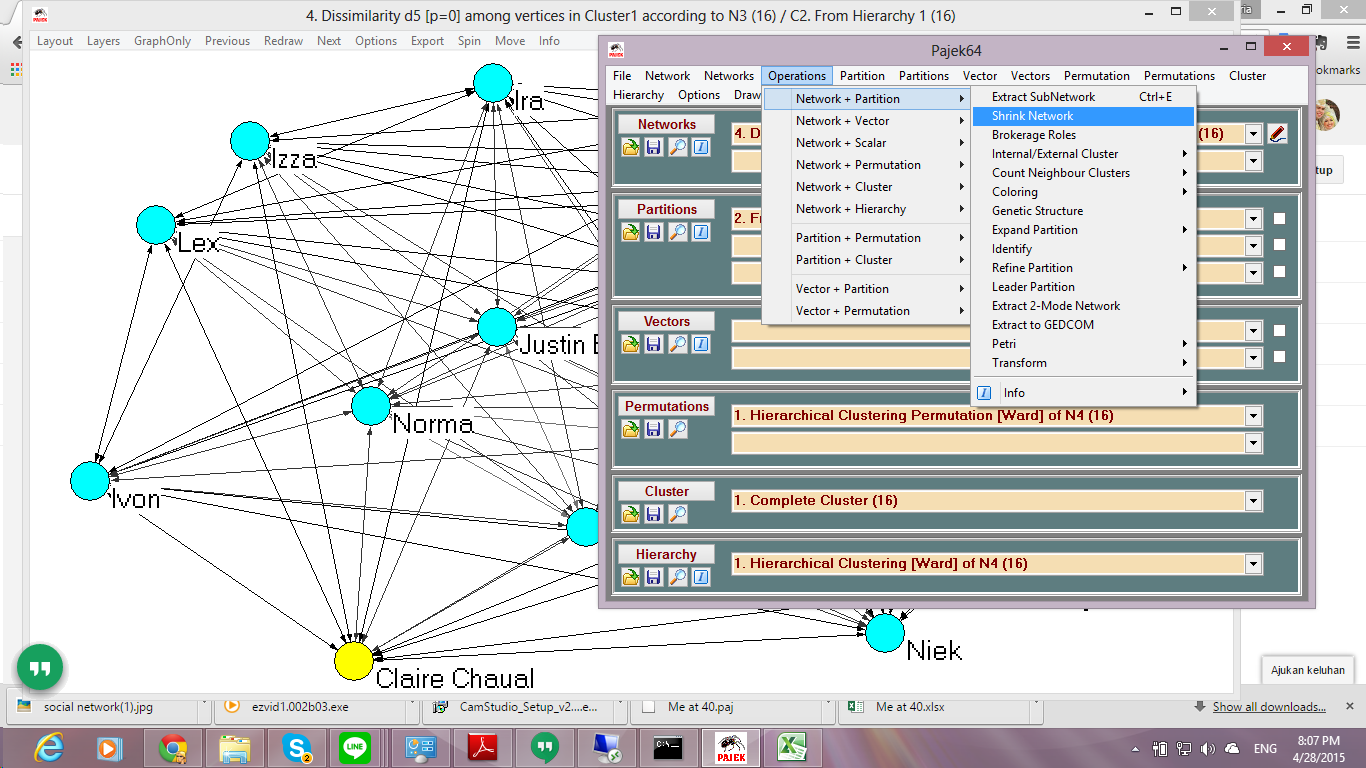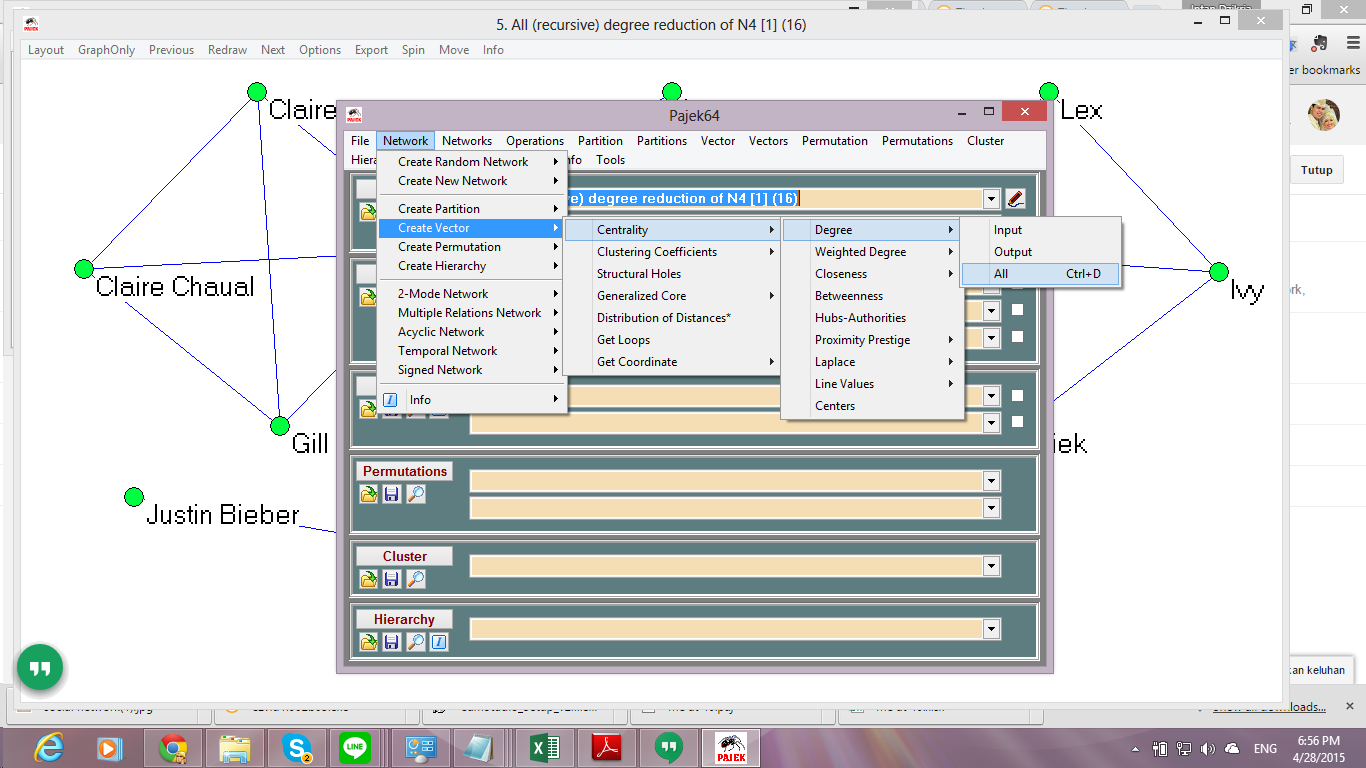This semester I got to learn something interesting called Social Network Analysis. At first I thought it's like social network kinda things, e.g. Facebook, Twitter, etc. But, actually those are social network website and the case for the analysis.
Let me tell you simple thing to think of. You have friends in Facebook right? And your friend have mutual friends with you, and your other friends too. These can build a network, called social network. This network can have many kind benefit, for example who are your friends that have highest influence in your network, so if there's any event you can ask them to tell your friends.
There are two kinds of network, 1-mode and 2-mode network. 1-mode network only have 1 event/actor. For example, your friends network only have your friends' name there. But, 2-mode network has 2 variables, for example your friends' name and their hobbies.
In this article, I will show you how to analyze 2-mode network. This article consists of several parts which are how to dimplify a network, find centrality, and do a clustering.
There are many software for social network analysis, but because I just learn about this software, Pajek, I will use this software instead. Pajek is a free software that you can download here.
First, Open your Pajek and click File - Pajek Project File - Read to read you .paj file
If you don't have .paj file you also can open .net file with clicking File - Network - Read
After you open your file, it will open a Report Window that shows you everything you've done using Pajek. Somekind like a Log windows.
Second, Draw your network with clicking Draw - Network
Your network will be shown in the drawing window. You can change the drawing using several algorithm provided in the Pajek. Just clik on
Layout - Energy - Kamada Kawai - Free or
Layout Enegery - Fruchterman Reingold - 2D

Another drawing will be like this. Every time you did the the drawing algorithm, it will show different results.
So, because it's a 2-mode network, you have to make it into 1-mode network first before continue to further analysis. Because it will show more comprehensive result from 2 variables (actor and event).
Third, Change the 2-mode to 1-mode network with
Network - 2 Mode Network - 2 Mode to 1 Mode - Rows (establish event projection)
Network - 2 Mode Network - 2 Mode to 1 Mode - Column (establish actor projection)
The difference between Rows and Column is in the projection. So, for example in here I have a network that the actors are students's name in the class and the events are the dreams. Vice versa.
After the changing into 1-mode network, if I choose the event projection, the drawing will only shown the relation of the students.
But, if I choose the actor projection, the result is only the dreams of the students.
Fourth, Simplify the Network
Let's see the event projection instead because it's more complicated than the actor projection. Because it's too complicated what we want is to make it simpler, but how?
We have to know first the value of each line. The meaning behind it is that one person can have more than 2 dreams, right? but teacher asked students to choose their dreams no more than 4. So, we have network that shown students' choice between 2 until 4 choices. And if we want to make the network simpler, it's up to us the minimum degree of the network.
Okay for example, I want to remove lines that lower than 3. It means, the network only shown students that have 3 and 4 choices of dreams.
To do this, perform this action in the Pajek. Click on the
Network - Create New Network - Transform - Remove - Lines with Value - Lower Than
A small window will pop up and insert your threshold value. Mine is 3. So, I type 3 in the box. Then click Ok. There will be another window appear but just click Ok.
When I draw the network, it will be like this. You can see there are several vertices or my friends in the class who have no line or link to another vertices, right? We want to make the network simple, so why not we reduce it?
To reduce the vertices that have no links, you have to perform this action
Network - Create New Network - Transform - Reduction - Degree - All
Degree in here is how many links the vertices have. For example, in here the minimum degree I want in my network is 1. Because Sherry and Pietsia have 0 degree, they will be removed from the network.
Input the minimum degree you want, for me I want 1. There will be another window that will pop-up and just click Yes.
When I draw the network, the vertices that have 0 degree is no longer exist in the network.
To see the line number, you can click
Options - Lines - Mark Lines - With Values in the drawing window.
Fifth, Save your Network
Finally, don't forget to save your simplified network for further analysis like for clustering because you don't want to perform the same actions from time to time right?
To save your network, you can do click Save button in the Networks section.or click
File - Network - Save.
I will go on to the next part of the Pajek tutorial. If you have any question about this part, please comment below. :)
Hope this post help you. ^^
You can see the next part in this
link





















.jpg)















